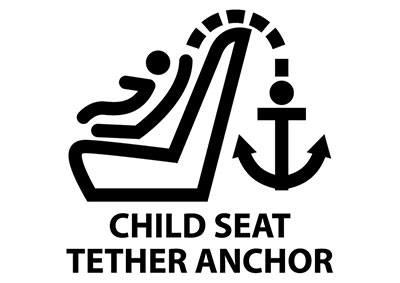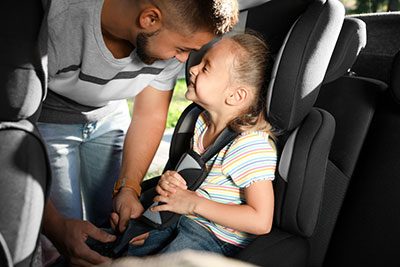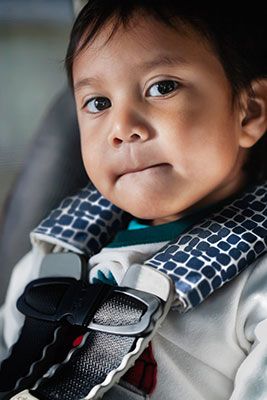As a parent, you know how important it is to keep your child safe and secure in their car seat. But are you unsure if booster seats should be anchored? The new laws are here, and we've got the explanation on whether or not booster seats must be secured by anchoring.
We'll break down exactly what's required so that you can make an educated decision about best practices for your family. Keep reading to get the details about does a booster seat need to be anchored - updated with the latest information!
More...
Take Away Key Points:
Table of Contents
- Should parents anchor their children's booster seats?
- 1. What does anchoring mean?
- 2. Can you anchor a booster seat?
- 3. What are the benefits of anchoring booster seats?
- 4. What happens if you don't anchor the child's booster seat?
- 5. What are different anchoring methods?
- 6. Which anchoring method is better for children?
- 7. Anchoring boosters with seat belts
- 8. Anchoring boosters with LATCH
- FAQs
- Summary
Should parents anchor their children's booster seats?
Keeping your little ones in child safety seats is always your top priority while in the motor vehicle. For this reason, we answer your questions about anchoring the booster seats. Read the guidelines to find the best answers and explanations.
1. What does anchoring mean?

Anchoring refers to the connection between the motor vehicle and the car seat. The car seat uses either a top tether strap or lower anchors to be firmly attached to the back seat of your vehicle. Different motor vehicles offer different connectors.
You might find rigid lower anchors, or flexible straps, while some other models do not provide any lower anchors. In that case, you should use the top tether to secure the car seat.
The top tether straps must be included in all forward-facing car seats, as the top tether strap keeps the child's chest, neck, and head in the proper position and prevents them from moving forward in frontal impacts.
But, since 2002, the vehicle has included the LATCH system in their vehicles. The LATCH stands for lower anchors and tethers. The lower anchors are metal U-shaped or horizontal bars. They are mostly hidden inside the vehicle's seat crease or can be visible by sticking out the crease. In most vehicles, there are two sets of lower anchors - on the driver's and the passenger's side in the back seat.
2. Can you anchor a booster seat?
Boosters do not necessarily need to be anchored. Their anchoring will depend on the models you're using. Most booster seats use the vehicle seat belt for installation, but it also depends on your motor vehicle.
The main reason for anchoring your booster seat is to position it correctly and reduce forward movement. Even though many booster car seats do not allow you to use the LATCH system, you can anchor the seats for extra security if possible. But let's see the further details to ensure the best anchoring methods.
3. What are the benefits of anchoring booster seats?
Using the LATCH system is not mandatory if the conditions do not allow you such use. However, if the instruction manual ensures the proper installation and your child's weight limit is within the LATCH method, do not hesitate to use the system to support your booster seat.
Still, anchoring your booster brings various benefits for your child's body condition. Firstly, your little one will be secured and fixed in the vehicle seat, and the system will prevent the ejection of the child's car seat in a frontal impact.
Secondly, your forward-facing car seat will not move while attached to the LATCH, even without crash forces. This is because the car seat cannot move around or change its position easily, as the connectors keep it optimal for the ride.
Thirdly, the vehicle's seat belt will work with the lower anchors and keep the child's body stable and fixed in the child's car seat. So, the child benefits from maximum safety standards when in the anchored car seat.
4. What happens if you don't anchor the child's booster seat?
No anchors mean no strong connections to the car. Once the vehicle starts to move faster, the booster seats without any connectors will keep shaking, making you anxious that your baby might fall off the back seat. So, anchoring your car seat is the best solution for your needs.
When a vehicle suddenly stops for any reason, the child might fall and suffer from severe pain and injuries. For this reason, experts recommend you fasten your booster seat to avoid even the slightest risks of injuries.
5. What are different anchoring methods?

The LATCH system is the best anchoring method to secure your booster seats when the car models allow it. The lower anchors work well with rear-facing seats, forward-facing combination seats, and high-back booster seats when the manufacturer states it is safe to use the lower anchors for the connection.
The LATCH is mainly used when the car seats when the child and the seat do not surpass the weight limit of 65 pounds. If the child outgrows the weight limits of more than 65 pounds, most manufacturers recommend vehicle seat belt installation.
Remember, you cannot use the vehicle seat belt and LATCH anchoring—only one method. If you opt for LATCH, the mechanism prevents seat ejection, while the seat belt keeps the child fixed inside the seat.
However, some high-backed boosters and even backless boosters use the LATCH system for additional positioning devices, so they are optimal for the stability of your children. And if your vehicle or booster seat does not offer the built-in LATCH tether anchors, you can use the customized anchors.
Your booster seat should have extra straps to lock with the lower anchors to keep the car seat optimal. These connectors work similarly to the vehicle's seat belt. On the contrary, some lower anchors have extendable straps to attach to the booster seats.
But, you must forget the top tether anchor to add more security and fixation when you use a booster seat. In addition, the top tether anchor prevents the high-back boosters and forward-facing seats in general from ejecting forward in accidents. So, top tethers keep your children optimal on the road.
6. Which anchoring method is better for children?
Both the top and lower anchors are a must for all parents for maximum safety standards for their children. However, the lower anchor might be a better solution for those preferring only one method, especially regarding backless boosters.
Since cars might shake only in the vertical direction, the booster seat needs lower anchoring. The lower anchors will prevent shaking of the booster seat and keep your car seat optimal. And, as the connectors attach to the booster seat in the lower area, they will nullify the vertical bumps of the cars better.
But, if you're taking a hard turn with your vehicle, the car seat will move horizontally. The top tether will do its job better, as it's vertically connected to the car seat.
Still, if you want the best safety standards for your children, using top and lower anchors is necessary. But, again, check the instruction manual for extra details.
Anchoring your booster car seats is not the best solution when you have the LATCH option. But, if you don't, you can anchor the car seats for your children with seat belts.
7. Anchoring boosters with seat belts
To anchor the booster seats correctly with the car seat belt system, you must ensure the following standards:
- The seat belt fits your child
- Booster seats must be used with lap and shoulder belts
- The lap belt must cover your child's upper thighs
- The shoulder belt covers the child's chest and does not touch their neck.
Will lap and shoulder belts protect children?
Don't worry if the high-back boosters do not have harness systems, as they use adult lap and shoulder belts. So, the seat belts will provide maximum stability for your child.
8. Anchoring boosters with LATCH
If your booster seats use the LATCH straps instead of seat belts, you must refer to the manufacturer's manual to properly anchor the booster seat. In most cases, the procedure is the following:
- If possible, install the booster seat in the center of the vehicle's back.
- Attach the car seat with the two belted hooks to anchor bars located on the seat's back
- Ensure the anchor belts are securely attached to the anchor points
- Pull the tightening strap to secure the lower part of the car seat
- Attach the top tether strap of the seat to the vehicle's seat
- Pull tightly to ensure the head of your child does not fall too forward during a crash
- Ensure the car seat does not move more than one inch in all directions when you shake it
- If the car seat does not move around, your child can freely use it. If not, you need to repeat the process to ensure the best stability for your child.

FAQs
Does a booster seat need to be strapped down?
No, backless booster seats do not need to be strapped down, as they use the adult seat belt.
Are backless booster seats anchored?
Not all backless booster seats are anchored. However, some models, such as Cleck Olli or Ozzi seats, use rigid LATCH connectors, so you can anchor them for the maximum safety of your child.
Summary
As you can conclude, anchoring booster seats are optional, but if you have the LATCH system, you should connect it to the seat. However, if your manufacturer recommends the weight and height rules, you might need only a seat belt to anchor the booster seats.
So, always refer to the car seat manual, vehicle owner's manual, and safety standards to choose the best solution. But does a booster seat need to be anchored? Yes, you must anchor the seat in whatever method you choose.
